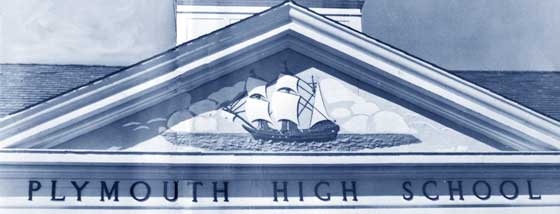| Classmates |
| Reunions |
| '63 Updates |
| 1963 Memories |
| News |

Memories of 1963
Events and Milestones
- Plymouth in Pictures from the Sixties
- 1963 in History
- More Events and Stuff
- Top 100 Popular Songs
- Some Top 40 Songs
Plymouth in 1963
The town we knew back in those far-off days was quite different from what it became once the new Route 3 and the construction of the Pilgrim nuclear plant (which lowered taxes) attracted thousands of new residents. The population was still, as it had been for centuries, concentrated in the northeast corner, so that what is now "West Plymouth" (formerly “Darby”) and "South Plymouth" did not exist. Manomet (pronounced locally with the emphasis on the first—not the last—syllable) was just beginning to shift from a summer resort to year-round residences. The population was 14,445 (it had increased very little since 1920, when the population was 13,045).
The downtown business district still provided most of the needs of the residents in 1963 – clothes from Puritan Clothing and Plymouth Men’s Shop or Buttner’s, Bernard’s and Anti’s; Hardware from Plymouth Supply, Plymouth Hardware, Bliss’s &c.; groceries from First National, A&P, Plymouth Rock Fruitland and all the various local markets; sports gear & records from M&M’s; books, papers and other stuff from Smith’s; liquor (for us, illicitly) from Corvini’s or Pioppi’s; neat stuff cheap from Woolworth’s (with their recently-added lunch counter and that ineffable scent of popcorn, perfume and pets), McLellan’s and Grant’s; furniture from Aron’s and Zanello’s; jewelry from the venerable Loring’s; baked goods from Danforth’s; drugs and sundries from Pilgrim Drug, Cooper’s and Bradley’s – one could go on and on, not to mention the parallel resources of North Plymouth and Manomet. Remember Currier’s, Gambini’s, the Bluebird, Jim’s Lunch, Danny Callahan’s, the Colonial (both the diner and the restaurant), Dearn and McGrath’s, Mayflower Seafoods – or farther afield, Star Lunch, the Priscilla Grill, the Seaside Grill, the Beachway, and Bert’s in its original incarnation – not to mention Tassy’s and Leland’s? The Old Colony Theater was still in operation, as was the Plymouth Bowl-O-Mat. It wasn’t just bars and places that buy gold, back then.
The downtown was also still the civic heart of Plymouth before everything “went south” to South Street, Obery Street and Long Pond Road, with the Russell Library, the police station (which took the place of the Cornish and Burton schools that year), the central fire station, the Boy's Club, the Methodist Church, the Masonic Lodge, the Elk's Club, and of course the Plymouth’s County Courthouse all located there.
Yet times were changing. The Summer/High Street neighborhood was quickly vanishing under urban “renewal”, Wood’s had already established its new location at the Town Wharf (no breakwater back then), and the Plymouth Rock Hotel building would soon become the Plymouth Wax Museum. Mabbett’s, like the Plymouth Cordage Company, was about to close and Puritan Mills was long gone. The field in front of Dearn and McGrath’s, where circuses and carnivals set up, would disappear under the sewerage facility. Malls were just beginning to appear, as were chains such as the A&W Root Beer on Samoset Street.
It’s been fifty years and those years have inevitably brought about changes in our old town. But we can still look back to what now seem like golden days when life was less regulated and more localized, and just as all our classmates have aged perceptibly from the yearbook photos, so Plymouth looks different today as well. Happy memories!